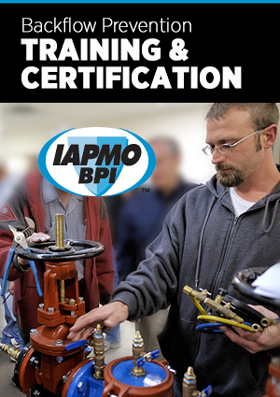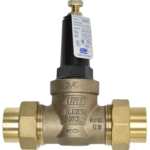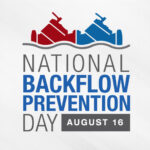I understand that each of us has a set of priorities and opinions that we hold. They are based on our understanding of the situation, our life experiences and on a number of other factors that affect us personally. I was thinking about this the other day after a call from an individual who reached out to me about a problem he was having in the jurisdiction in which he lived. He had spoken to me several months earlier about this situation and I had urged him to sit down with the local water company, express his concern and let them decide the correct course of action. He had failed an assembly because the distance from the grade to the bottom of the assembly was only ten inches, not the twelve inches required by regulation. He had sent me photos of the installation which showed a large reduced pressure principle assembly in a parking lot about thirty yards from the facility it served. The lot had been resurfaced which was probably a factor in the height issue. The tester had told the building owner that the valve needed to be raised up to the minimum twelve-inch clearance in order for him to pass the assembly. The building owner was not interested in going though the time and expense of re-piping the assembly to raise it two inches, so he simply hired another certified tester to come out and test the assembly, who passed the field test and sent the required forms to the water company.
The original tester had spoken to the city inspector and the water company’s cross-connection supervisor and both had agreed that while the assembly was below the required height there was no chance of the valve being submerged and there were adequate clearances for testing and repair. They both agreed that if it was a new installation, they would have required it to be raised but since the valve had been in place for a number of years forcing the property owner to spend several thousand dollars to raise it was unnecessary. This decision was not sitting well with the original tester, so he reached out to me for help. Since the state he was in uses the Uniform Plumbing Code he wanted me to write a letter to the city, state, and water company informing them that they were in violation of the code and since the code was adopted by regulation, they were breaking the law itself. I declined to write that letter and in speaking with him said that officials have the power to grant variances in certain situations and that as backflow testers we do not have the power to mandate that consumers do anything. We can suggest things. We can report issues to the proper officials. If needed we can walk away from situations or customers we think are unethical or problematic. In the end the tester did not take my advice, he contacted state and city officials, including the attorney general, to voice his displeasure. He even took issue with IAPMO for not enforcing the plumbing code in the state.
What occurred here really got me thinking about what is important. In the case of the situation we have been discussing so far, I would have to say I agree with the city inspector and the water company employee on this issue because it was an existing assembly. A new construction installation would be a different matter. The valve was installed and was being regularly tested. While two inches below regulation, it would take a flood of biblical proportions to really cause an issue. Is this the hill we really want to climb and plant our flag while we fight to the death? For the original tester it was. He lost a customer and in pushing this matter as far as he did, he really lost any good will he had with any of the people involved. These situations come up in the cross-connection industry all the time. What issue out there should we be willing to fight to the death on? What truly is important? I let you know my thoughts and I would really like to know and share yours. When you finish this editorial think about it and send me your thoughts at sean.cleary@iapmo.org or hit the comment button at the bottom of the page.
Let’s start with what I don’t think is a critical issue in the industry:
1- What test procedures we are using in a specific jurisdiction?
In my experience there are several nationally recognized test procedures out there and if used correctly by a certified tester they all provide the correct results.
2- What type test kit the tester is using?
Electronic or analog, two, three, or five valve, Barton or Mid-West, as long the test kit they are using is calibrated and used correctly everything is good.
3- Who is doing the testing?
When it comes to testing, as long as they have completed a quality tester certification class successfully and taken a third party administrated and proctored written and practical exam to become a certified tester, I am good with them testing assemblies. They can be plumbers, irrigation personnel, pipefitters, sprinkler fitters, waste and water people, and several other disciplines. Installation or repairs is another issue. That is where licensed plumbers should be required in most cases.
Now let’s look at what I think are critical issues in the industry where we should be expending time and treasure.
1- Public education on the importance of backflow protection and cross-connection control.
This is our most important task. We need to work on a local and national stage to continue to push this issue and it is something that all our industry associations and groups should be working on together.
2-Tester Training and Third-Party Certification of testers.
As someone who does training in a number of states, I have seen an increase of training providers in many areas. Competition is a good thing. A monopoly does not serve the industry well and stifles innovation. With that being said, we need a minimum standard to ensure the quality of a tester. Several industry groups put out a position statement several years ago. 40 hours of training and the testing of the four assembly types was promoted. In some areas of the country we have 16 or 24 hour classes, we have the same individual teaching the class, writing the exams, correcting the exams, and giving out the certifications. In some cases, the industry needs to police itself. The ASSE Series 5000 Cross-Connection Control Professional Qualification Standard is adopted in all three model plumbing codes and requires 40 hour classes and third party certification. It can be used as a blueprint for jurisdictions. Several of the current national certifications already conform with the requirements of the ASSE Series 5000.
3- Recertification including written and practical exams should be required in all jurisdictions.
We still have areas that do not require recertification or allow individuals to use CEU credit in classes unrelated to backflow testing to renew their tester certification. Again, we need to adopt an industry standard mandating training and testing for certification.
4- Improved enforcement of the requirement for the annual testing of all backflow assemblies including both isolation and containment assemblies in residential and commercial facilities.
5- Education programs for plumbing, mechanical, and building inspectors and officials including plan reviewers in cross-connection control.
6- More participation be backflow groups and associations in the model codes committees and in the code update process.
Those are my thoughts. I look forward to hearing yours.
About the Author |
|
 |
Sean is a 40 year member of the United Association Local 524 Scranton Pa. He has worked in all phases of the plumbing and mechanical industry and is a licensed master plumber. Sean is a Past President of the American Society of Sanitary Engineering. Sean is also the member of the ASSE Cross-Connection Control, Technical Committee. Sean is employed by IAPMO as the Vice President of Operations for the IAPMO Backflow Prevention Institute. |






 19 Nov 2019
19 Nov 2019
 Posted by Sean Cleary
Posted by Sean Cleary 














5 Comments
I think that c36 license should be a requirement in conjunction with certifications when dealing with public health.
Good article, thanks Sean! Over zealous testers/inspectors do more harm than good in my opinion and in the case you cited, the tester overstepped. Personally, I’m just happy to see they have the correct valve installed and have it tested regularly. Beating someone up for the sake of a couple of inches of clearance is ridiculous IMO.
I’d like to comment on a couple of the critical issues you highlighted:
2-Tester Training and Third-Party Certification of testers.
In Canada we worked hard to incorporate a national CCC manual. Now all testers and teachers learn and teach from the same manual. The benefit to the tester is that this allows for nationwide reciprocity, so a tester relocating from one province to another is fully certified. We also have mandatory recertification every 5 years. When we first introduced this, it weeded out a lot of people who shouldn’t be testing and it keeps testers up to date with the latest test requirements. We also require 3rd party proctors at exams and the test papers are assigned and marked by our local AWWA office. Proctors are also required to take training as well and have a uniform approach to marking practical tests.
5- Education programs for plumbing, mechanical, and building inspectors and officials including plan reviewers in cross-connection control.
For the last 15 years I have conducted half day training for our local health authority. Health inspectors inspect all the restaurants in our city at least once annually. Most of the training is geared toward students who are in or just graduated from technical school and is focused on the hospitality industry. Health inspectors can play an important part in any cross connection program, so establishing a good relationship with them is one of the keys to success.
#5 Educate the Health Dept. Inspectors. They are in every restaurant at least once a year, more eyes the better.
Sean, the only point we have ever been unaligned on is the installation of permanent platforms. They are better than no access. Flush in Peace
As a Plumbing/Mechanical Inspector I will enforce the code on any new permitted installation, and issue a notices for issues found through submitted test reports. The contractor who installs an assembly correctly with regard to degree of hazard, possible drainage, and accessibility for maintenance should be rewarded with a green tag. The contractor that is lacking in respect to the requirements of the code, needs to be corrected. As an Instructor, I encourage my students to do their best to educate their customers about the importance of a proper installation and testing Backflow Prevention Assemblies. If during an inspection of an assembly and deficiencies are identified , the tester should continue to test the assembly, and submit the report with any deficiencies listed on the comment lines. Leave the Code enforcement to the AHJ. As you have stated the customer will just hire someone else, and the next guy might not be as well trained. With well over 400,000 water accounts in our system, and only a few inspectors we need the eyes and ears of qualified people to help us protect the health and safety of the public.
Getting a certified HVAC technician that you can trust can be tough